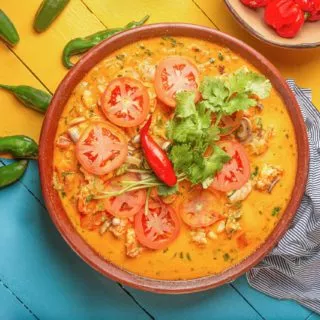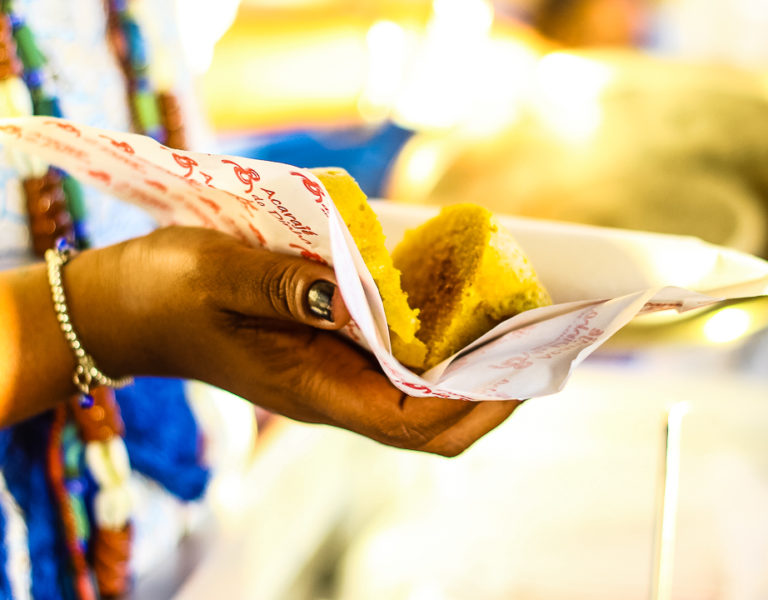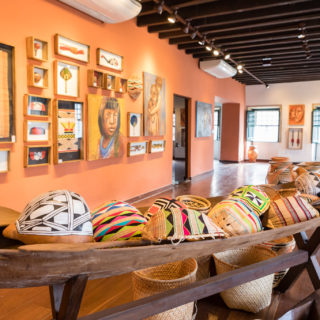
Acarajé’s cousin, and Oxum’s “secret weapon”, the abará is one of the delicacies on Bahia’s trays
The cuisine in Bahia is formed by a cultural syncretism of indigenous, African and Portuguese cuisines. Bahian food mixed with all other cultures, giving it a unique character in Brazil and in the world. The trays of the baianas de acarajé are the main representatives of this combination of flavors. They can have acarajé, abará, passarinha, porridge, lelê, bolinho de estudante, cocada, pé de moleque and others. Here, we tell you a little about this gastronomic delight of Bahia: the abará.
The abará is the acarajé’s “cousin”, made in almost the same way. The big difference is that the abará is cooked, while the acarajé is fried. The abará is a ground black-eyed bean dumpling, cooked in a water bath, wrapped in a banana leaf.
This is a typical dish of African cuisine and Bahian cuisine, prepared with the same precepts of African-based religions. Its origin has the mark left by former enslaved people, from when it was served in rituals and religious festivals, or sold by women who set up their trays in the streets of the Historic Center. The customs are practically the same until today.
Today, almost all the baiana’s trays around the city serve the delicacy. One of the most famous abarás is that of Regina dos Santos Conceição, who has had a fixed point* in Rio Vermelho for over 30 years and another in Graça.
The abará and the stories of Jorge Amado
For those who love the work of Jorge Amado, the abará appears in: The Country of Carnival; Jubiabá; Gabriela clove and cinnamon; The Two Deaths of Quincas Wateryell; Shepherds of the Night; Dona Flor and Her Two Husbands; Tent of Miracles; Tereza Batista: Home from the Wars; and The War of the Saints.
“The other shepherdesses descended from the hill, Gabriela came from Dona Arminda’s house, they were no longer just shepherds, they were saint’s daughters, Iansã’s iaôs. Each night Mr. Nilo released the joy in the middle of the room. In the poor kitchen, Gabriela produced wealth: copper acarajé, silver abarás, the golden mystery of the vatapá.” (Gabriela clove and cinnamon)
Ingredients
Originally, like the acarajé, the abará was served without any additional ingredients. Over the years, it gained some fillings, and now it can be served with vatapá, shrimp, caruru, salad and, for those who like it, hot pepper.
In the recipe: black-eyed beans, palm oil, dried shrimp, onion, salt to taste and banana leaves to wrap.
How to prepare: let the beans soak for at least 12 hours. The husks that come out must be removed. Blend the beans until a homogeneous mass. Then blend the onions and shrimp and mix with the bean dough. Add the palm oil. Remember that dried shrimp must be boiled to remove the salt.
Soften the banana leaves on the fire and start rolling the dough. Make a base of banana leaves at the bottom of the pan and arrange the abarás on top. Add water without touching the abarás. It should be steamed for approximately 40 minutes, so it’s a good idea to cover it with a banana leaf or cloth.
The traditional abará dough today has some variations, in which ground cashew nuts, ground roasted peanuts and a small piece of ginger are added.
The origin of the abará
Always very poetic, the food of African origin brings many stories from the mythology of the orixás.
The book “Cozinhando Histórias – Receitas, Histórias e Mitos de Pratos Afro-brasileiros” (Cooking Stories – Recipes, Stories and Myths of Afro-Brazilian Dishes), written by Josmara B. Fregoneze, Marlene Jesus da Costa and Nancy Sousa, better known as Dona Cici*, tells the myth of the abará.
According to legend, one day, Xangô, king of Oió, decided to go to war against an enemy tribe. He sought out Iemanjá, his warrior mother, who immediately took her weapons and left with Xangô; he also called Oia, his young wife, who joined him and took her fighting gear; he went to Obá, the old and great warrior, who in the blink of an eye was ready.
Then Xango looked for Oxoce (or Oxóssi or Oxossi or Òsóòsì), his brother, but Oxoce said no, and immediately turned into a wild boar and disappeared into the forest. Oxoce never forgave Xangô for having robbed him of Oxum, who was his wife.
The next one that Xangô sought out was Ogun, saying: “My brother, are you by my side in this war?” Ogun replied: “yes, I’m your guy!”. Xango’s army grew more and more.
Finally, Xangô arrived at Oxum’s palace and called her with three greetings. When Oxum appeared, Xangô asked: “My beautiful queen, will you fight by my side?”
Oxum asked for her throne and sat quietly. Xangô asked for the second time, and then she said she needed her abebé (fan) and more jewelry. Oxum’s wishes, once again, were granted. Asked again by Xangô,
Oxum, before answering, said that she would like to have her dolls.
Xangô, very angry, said: “A woman who cares about her throne, her jewels and her dolls doesn’t want to go to war.”
Oxum returned to his palace in the company of his faithful friend, Oxumaré, who is sometimes in human form, sometimes in the form of a serpent coiled on the throne of Oxum, and sometimes in the sky in the form of a rainbow.
Finally, Xangô went to war, fought great battles and defeated his enemies, who were taken as slaves. The goods and slaves were shared between the warriors and Xangô began the return to his lands. However, some enemies managed to escape and prepared an ambush for Xangô.
Meanwhile, Oxum, in his palace, received information about the war from Oxumaré who, in the form of a rainbow, sees everything. Oxumaré said: “My lady, Xangô won the war and is on his way back, but some of his enemies who fled are very close, with the objective of taking revenge and destroying Xangô’s kingdom.”
Oxum promptly ordered that many abarás were made, and when they were ready, she ordered everybody to back off. Immediately, Oxum turned into a mighty river and, with terrible noise, ran towards Xango’s enemies. When it got close to the enemies, its waters were calm and the abarás began to float.
The enemies, weary and hungry, entered the waters and had plenty of abarás. When everyone was in the water, the river disappeared into the land, taking away all of Xangô’s enemies. Then, a great rainbow crossed the sky and brought the news to Xangô, who asked: “Who was the warrior who defeated all my enemies in a single battle?”
Oxumaré said: “It was Oxum.”
Amazed, Xangô asked: “How is it possible for a single woman to defeat so many brave warriors?”
Oxumaré said: “The answer lies in the infinite powers of Oxum”.
Footnote:
Acarajé da Regina – Largo de Santana, no number, Rio Vermelho, Phone #: 3232-7542. 3pm/10pm (Saturday, Sunday and holidays 10:30am/8pm); Rua da Graça, no number, in front of Colégio Sartre, Graça. Thursday and Friday, 4pm/9:30pm. Open since 1979.
Books:
“A comida baiana de Jorge Amado ou O livro de cozinha de Pedro Archanjo com as merendas de D. Flor”, by Paloma Jorge Amado Costa.
The myth of the abará has been adapted for this article. It was taken from the book: “Cozinhando Histórias – Receitas, Histórias e Mitos de Pratos Afro-brasileiros” with photos by Pierre Verger. It was written by Josmara B. Fregoneze, Marlene Jesus da Costa and Nancy Sousa, better known as Dona Cici.

















